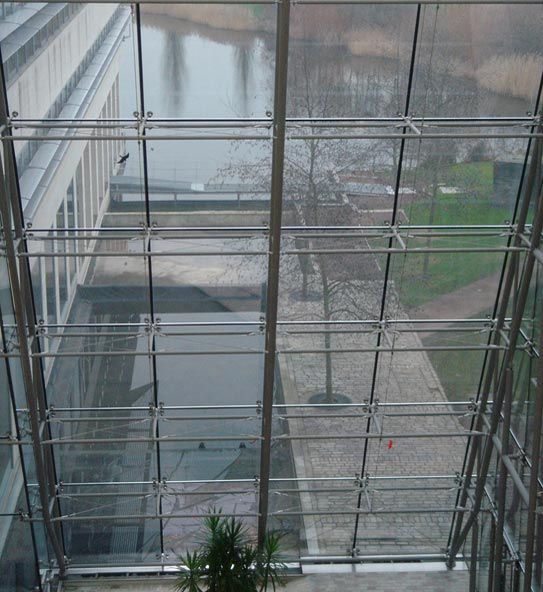



Medium:
Audio walk
Duration:
5 minutes
Commissioner:
Curated by Susie Allen of Artwise for British Airways, Waterside.
Janet Cardiff
| The British Airways building was designed as a type of village with theme sectors that reflected all of the places where the airline flies. There is the Africa house, Asia house, and house of the Americas, all of which I found very sci-fi and utopian. It was also built on the site of an historic village. The archae-ologists had found lots of interesting debris while excavating for the building, which inspired the main narrative. Also, at the same time I read a fictional story, written in the late 1800s, about London being awash in water. So the three elements combined in this piece to form a loose narrative of a woman in one dimension looking for her mother in another.
PA Mech. voice System All new arrivals please report to station 8. Tolerance is a virtue. sfx of running water in fake stream beside bench Janet Sometimes sitting beside a stream or a river I think I hear voices, words formed by the changes in the current. Janet I’m looking for someone. I know she’ll eventually return here. Janet Walk past the fountain, down the stairs and into the square. The security guards are watching us from the tower. scary music and then a voice from movie says PA Mech. voice System All personnel in Africa House please report to Station 10. A good beginning is half the work. A work well-begun is half done. Janet There are a lot of people on the bridge, little shops, with advertising banners hanging down, wooden structures with people living in them. Kids running across. Older Woman I carried you in my arms, making the trip into the city by foot. The cars had been abandoned. Heaps of metal beside the road. There was only enough room in the boats for the children. I remember your fingers grasping at my face, your open mouth screaming. Man’s vox reading in film noir-type voice “You might find these interesting,” he says as he drops the package onto my desk. A stack of handwritten letters, individually wrapped in clear plastic envelopes. Water has gotten into some of them and the writing is blurred. They’ve been found in the river over the last six months, he tells me. I unwrap the top one carefully and look over it. A fine, old-fashioned handwriting. I glance up at the date; June 15, 2011. “Ha, some kind of practical joke” … I look up at him. He’s not smiling … “Just look them over and tell us what you think he says.” |
|
| From the very first moment of her walk in Münster, I became both haunted and intrigued by Janet Cardiff ’s work. I was determined to find a project that she would find stimulating and want to do with us at Artwise. At the time we were working on a very challenging program for British Airways at their new headquarters near Heathrow Airport at Waterside. It was the only building in the first new park to be built in the London region since Victorian times. It is an extensive and hilly moorland park with streams, wildflowers, and two lakes attracting wildlife, especially birds. The widely acclaimed Waterside building was designed by the Norwegian architect, Niels Thorp, and built around the concept of an indoor street. It was paved with reclaimed cobble stones, lined with trees, cafes and seating areas, and included a small supermarket, a bank and, of course, a travel center. It was one of the first attempts at embracing the concept of “hot desking,” which means that employees are not bound to a desk and instead carry their laptops and phones to wherever they need to be or are comfortable.
Janet and I first met at Heathrow and we had arranged to take her straight to Waterside so she could see the building in daylight. She liked the site and cathedral-like aspects of the interior street. The Waterside Walk takes participants along the street to a pavement cafe, up a lift and across a bridge to a crow’s nest high above the busy street. During World War II the area was used as a camp for the Canadian Air Force, and there is even a memorial in the park commemorating the dead that Janet weaves into her story. Layered sounds create a fragmented narrative that evokes imagined histories and memories, a past, a present, and a future. It is composed from snippets of conversation recorded on site, samples of choral music sung by the people who work there and their children, as well as the sounds of war, and Janet’s inimitable voice. The most notable element in the legacy of Janet’s work with the building and the walk is the British Airways Choir. Following from her observations about cathedral-like qualities of the street, she sent a message through the company asking for singers. It generated a sense of pride about the walk amongst the workers. A year later I visited the building around Christmas time to discover a quite substantial choir singing in the street to an enthralled audience watching and listening from the cafes, bridges and walkways. It was quite magical and I think Janet would be amused and happy at what her Waterside Walk had seeded. Susie Allen |